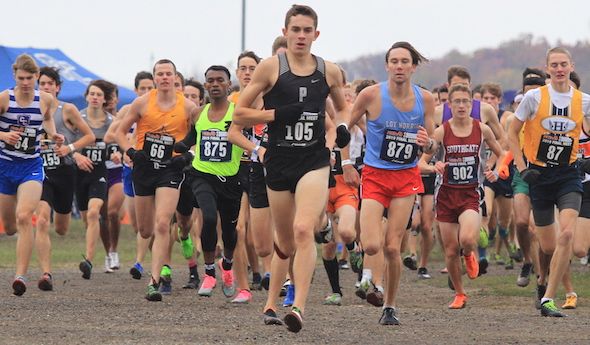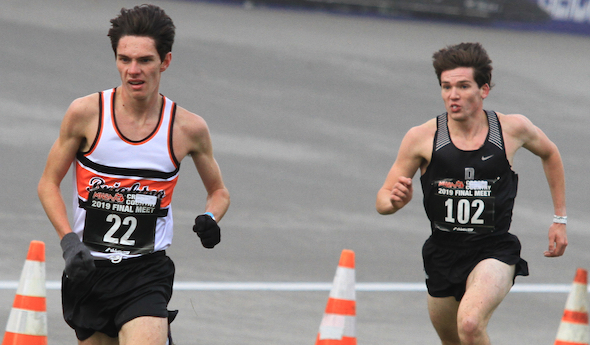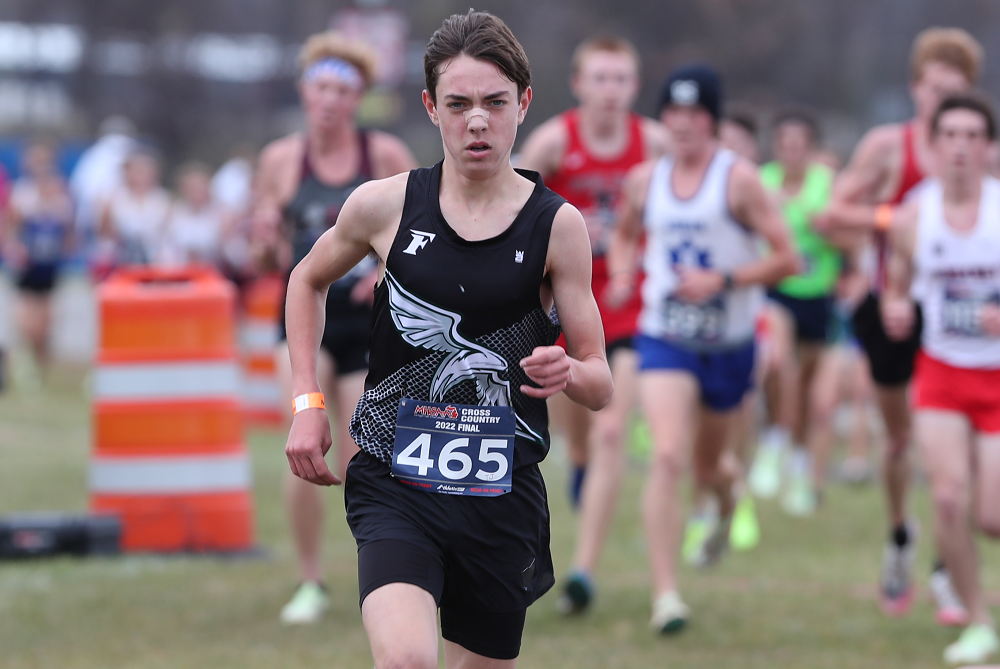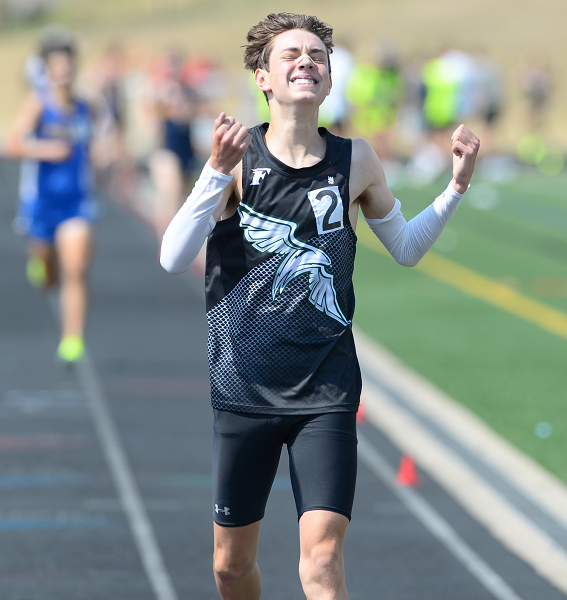
Friendly Foes Deliver Division 1 Show
November 2, 2019
Second Half reports
BROOKLYN – Carter Solomon could finally relax, a luxury he couldn’t afford himself for almost 3.1 miles.
The Plymouth senior had the fastest time in the state this fall and was fourth in the Foot Locker National Cross Country Championship last year, accomplishments that didn’t intimidate the other two runners who clung to Solomon in pursuit of the same dream.
When Solomon had finally shaken his rivals and was in the clear, he thrust his arms in the air in a display of emotion he rarely showed while winning races all season.
He had finally checked off the final box on one of the best high school cross country careers in Michigan history.
Solomon won the MHSAA Lower Peninsula Division 1 individual championship at Michigan International Speedway with a time of 15:01.2, the fastest time in any division Saturday.
“I think I came in as the favorite, but coming away with it still means a whole lot,” Solomon said. “People had me as the favorite, but these guys are coming for me. In my head, I was the third guy coming into this race. These guys are legit. I raced how I wanted to race, and it worked out.”
In his career, Solomon won a team championship with Plymouth last year, made All-America at Foot Locker and put himself in select company by earning all-state for the fourth time Saturday.
Solomon placed in the top 18 all four years. The only boy to accomplish that feat in the MHSAA’s largest classification since separate team and individual races were discontinued in 1996 was Rockford legend Dathan Ritzenhein, who made the top five four years in a row from 1997-2000.
 Only two other boys have even been four-time all-staters in the top classification: Lake Orion’s T.J. Carey (2009-12) and Brighton’s Zach Stewart (2016-19).
Only two other boys have even been four-time all-staters in the top classification: Lake Orion’s T.J. Carey (2009-12) and Brighton’s Zach Stewart (2016-19).
Running stride for stride with Solomon for much of the race were Clarkston senior Brendan Favazza and Brighton senior Jack Spamer. Favazza finished second in 15:06.0, and Spamer was third in 15:17.1.
“It helps when you’re best friends with him,” Favazza said of Solomon. “He pulled up right beside me when I took the lead and he said, ‘Let’s go one and two together; this is it.’ I’m like, ‘This is the guy. I’m sticking with him the whole way.’”
While Spamer was third in the battle for the individual championship, he got the prize that Solomon and his teammates won last year.
With Spamer in third and Stewart in fourth in 15:30.7, Brighton won its first MHSAA championship since 1995 and third overall by a 136-154 margin over Dexter.
Senior Scott Spaanstra was 31st in 16:05.4, just missing an all-state berth by one place. Sophomore Evan Ross took 46th in 16:17.6, and senior Andrew Hanna took 114th in 16:45.8 to complete Brighton’s scoring.
It was the fourth MHSAA Final meet for Stewart and Spaanstra and the third for Spamer, but the other four Brighton runners were competing at MIS for the first time.
“We didn’t need to run any A-plus races,” Stewart said. “We just needed to have an average day. We came out and did that.”
PHOTOS: (Top) Plymouth’s Carter Solomon (105) pulls to the front of the pack near the start of the Division 1 Final on Saturday. (Middle) Brighton’s Zach Stewart stays a few paces ahead of Plymouth’s Patrick Byrnes as the two went on to finish fourth and fifth, respectively. (Photos by Matt Yacoub/RunMichigan.com.)

Freeland's Hansen Not Focused on Joining All-Time Greats - But On His Way
By
Paul Costanzo
Special for MHSAA.com
September 29, 2023
The goal written on Matt Kaczor’s Post-It Note was sub-15 minutes, 15 seconds. That’s what the Freeland cross country coach was hoping for from star runner TJ Hansen during his junior season.
 Kaczor tore it up after seeing Hansen run a single race this fall.
Kaczor tore it up after seeing Hansen run a single race this fall.
“Knowing what he did over the summer and where he was at, seeing what his 1,600 (meter) and his mile got down to, I had a feeling he could get under 15:30 quickly,” Kaczor said. “After the first race, I looked at my assistant and was like, ‘I’ve gotta rip up that Post-It Note. I don’t think our goal is on the level of where he’s at right now.’ At first, it was break 15:15. Once I saw him race at the Under the Lights (on Aug. 18 at St. Johns), I was like, ‘Yeah, he’s going sub 15.’”
Hansen ran 15:39.6 in that first race, and on Sept. 7, in Shepherd, he ran 15:13.9 to meet the goal written on the now-shredded Post-It Note.
This past Saturday, he ran 15:03.7 at the Cadillac Veterans Serving Veterans Invitational. It’s the fastest time recorded in Michigan this year, and a signal that Kaczor might be filling out a new Post-It Note before the season is out.
“The sub-15 barrier, that’s been something on my mind for a while,” Hansen said. “Now that I’m edging closer and closer to that, it’s been exciting. With how heavy my training has been, I wouldn’t expect (to have run this fast this early). Being able to run the times I am really paints the picture for what’s ahead.”
Hansen came into the season already regarded as one of the elite distance runners in the state. He won the 3,200 meters at the MHSAA Lower Peninsula Division 2 Track & Field Finals this past spring. He’s also finished all-state (12th and fifth, respectively) the past two seasons at the LPD2 Cross Country Finals.
His current trajectory, however, would put his name near some of the state’s all-time greats. But that’s not something Hansen is focusing on.
“I really don’t like to compare myself to others,” he said. “I don’t focus on that. I try to be the best TJ Hansen that I can be. The best version of myself.”
Focusing on himself is almost necessary for Hansen, as he’s spending a lot of time during his races running by himself.
At each of the big events Freeland has run in this season, Hansen has finished at least 20 seconds ahead of his nearest competitor. That includes all divisions of the Duane Raffin Festival of Races in Holly.
In Cadillac, where Hansen ran his current best time, he was a full minute ahead of the rest of the field.
 “He’s just a special athlete,” Kaczor said. “I can’t see Freeland having someone like this in a while. He’s a generational talent. What’s crazy is, I had the school record when he was a freshman. He and Braden (Honsinger) broke it last year. But TJ has now dropped that school record (set in 1998) by almost a minute.”
“He’s just a special athlete,” Kaczor said. “I can’t see Freeland having someone like this in a while. He’s a generational talent. What’s crazy is, I had the school record when he was a freshman. He and Braden (Honsinger) broke it last year. But TJ has now dropped that school record (set in 1998) by almost a minute.”
Hansen’s achievements have already put him on a path to run at the next level, which is something of a family tradition.
His older sisters Peyton and Kiera are track & field athletes at Wayne State and Eastern Michigan, respectively. Their parents, Tim and Pam, were track & field stars at Central Michigan.
TJ has drawn the attention of coaches around the country, including from Michigan, Michigan State, Wisconsin, Tennessee and Colorado.
Having family members who know the process is a help for Hansen, and he said they’ve all been good about allowing him to choose his own path, whatever that may be.
“He’s from a good family that knows how to work and knows how to get things done,” Kaczor said. “He knows that if he puts in the work, he’s going to be at a good spot.”
While Hansen admits it can be a bit overwhelming, he’s using it as motivation to run faster and continue to put his name out there.
Also serving as motivation is 2022 Division 2 champion Connell Alford of Chelsea. Alford is among the elite group of runners in Michigan who have broken the 15-minute mark, doing it twice a year ago.
He currently has the state’s second-best time behind Hansen’s this year, running 15:09.1 at the MSU Invitational on Sept. 15.
“Whenever I see him drop a time, my main goal is to run faster,” Hansen said. “Whenever I see him run a good time, that motivates me to work hard.”
The two won’t see each other until the MHSAA Finals on Nov. 4 at Michigan International Speedway. It’s an opportunity Hansen is excited for, as it’s a chance to race and be pushed toward the lofty goals he’s set for himself. Kaczor is excited about it, too, even if it might mean having to replenish his supply of Post-Its.
“We don’t talk about winning the state title; we talk about making sure that we have great races on those days,” Kaczor said. “We can’t control how somebody else runs. It’s a matter of can we, if the weather is right and the course is in good condition, can we be one of the few guys that has run in the 14s on that course? That’s the goal. Put yourself in some great categories with those upper echelons and the greats of all-time.”
 Paul Costanzo served as a sportswriter at The Port Huron Times Herald from 2006-15, including three years as lead sportswriter, and prior to that as sports editor at the Hillsdale Daily News from 2005-06. He can be reached at [email protected] with story ideas for Genesee, Lapeer, St. Clair, Sanilac, Huron, Tuscola, Saginaw, Bay, Arenac, Midland and Gladwin counties.
Paul Costanzo served as a sportswriter at The Port Huron Times Herald from 2006-15, including three years as lead sportswriter, and prior to that as sports editor at the Hillsdale Daily News from 2005-06. He can be reached at [email protected] with story ideas for Genesee, Lapeer, St. Clair, Sanilac, Huron, Tuscola, Saginaw, Bay, Arenac, Midland and Gladwin counties.
PHOTOS (Top) Freeland's TJ Hansen leads a pack during last season's LPD2 Final at Michigan International Speedway. (Middle) Hansen enjoys a moment of exhilaration after winning the 3,200 this spring at the LPD2 Finals at Ada Forest Hills Eastern. (Top photo by Carter Sherline/Run Michigan; middle photo by Dave McCauley/Run Michigan.)

